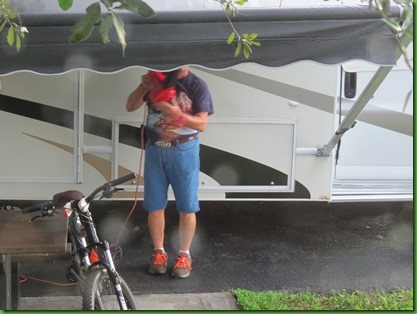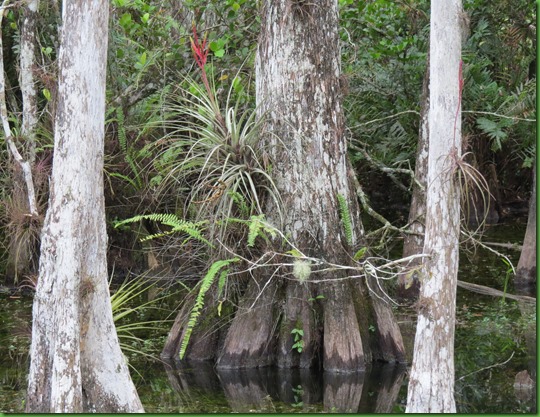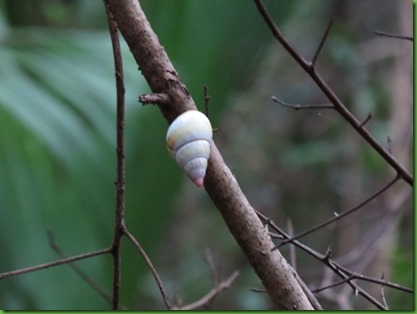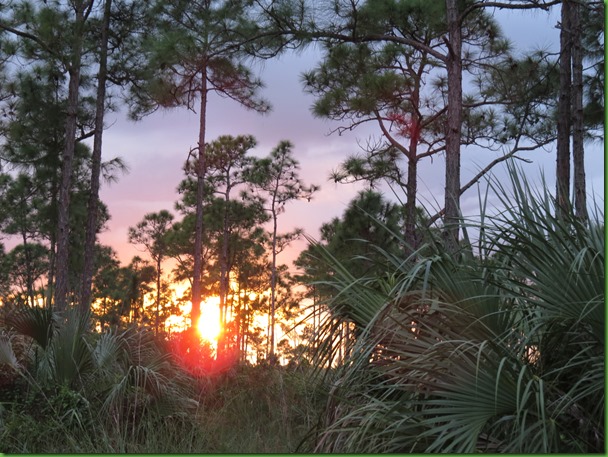Saturday January 2, 2016 Most Recent Posts:
Midway Campground Big Cypress V.C. and Boardwalk
Big Cypress National Preserve The Inspiring Life and Art of Clyde Butcher
Ochopee, Florida
Don’t you really love looking out your windows and seeing your neighbors doing hilarious things? These pictures are for Nancy Mills. David and I bet Bill isn’t quite this meticulous. This guy is using a leaf blower to dry off his picnic table and his awning. I’m so glad he was cleaning up to leave since leaf blowers are one of the noises I am so happy not to have much in my life any more.
Normally on week-end days we hang around the campground to avoid the invasion of the week-end warriors. We’re leaving Big Cypress tomorrow though and we wanted to see what’s new on the Monroe Station Loop drive and especially to hike the short Tree Snail Hike near its end.
Monroe Station is one of the original buildings on the Tamiami Trail completed in 1928 or 29 as one of six service stations built at regular intervals along the new road to assist travelers. Over the years it was a tavern and roadside inn. It’s now closed due to structural problems and is seriously deteriorated. They claim it is slated for renovation and is on the historic register but if either of those are true someone is really derelict in their responsibility since it is really in terrible shape with holes in the roof and it looks like it could fall down. That’s why I didn’t take a picture of it. I was really disappointed in the park service and in the historic register for allowing this.
As you can see the road is not paved. It is gravel for most of the way but in very good shape this year. We have seen it when it was not so smooth and pot-hole-less..
There is a guide to the Loop Road Scenic Drive available from the Visitor’s Center. It has many suggested stops but having done the road before, we make our first stop at mile 2.2, the trail head for the Gator Hook Trial. This is what I think of as a Beginners unguided swamp walk. We’ve hiked part of it before but it was so poorlly marked that we were concered about continuing on without clear trail markers or a GPS with waypoint capabilities. So we turned back. We were really disappointed since we’d done a guided swamp walk from the visitors center and were anxious to do it again. We are assured by some folks we meet coming back (the trail is out and back) that it is now very well marked. But we haven’t come to do it today after having the ranger say it came up to his hips which would be over my waist. I need better swamp walking clothes to do that but I’d love to be chest high in the swamp. Seriously it’s not scary, it’s gorgeous and the water is crystal clear.
In South Florida’s subtropical environment, the seasons are reflected in the changing water levels. During the dry season, the wildlife activity concentrates in the shrinking water holes. Dry season used to always be winter. But now things are so chaotic that in 2015 it was summer and the winter is rainy. Is it El Nino? Or Climate Chaos? How will it affect all of those who live here and depend on the seasons both plants and animals.
The picture above is of the dryer area around the trailhead of Gator Hook. Before heading down the trail I take some pictures of this Florida White Butterfly flitting around
and of this spot of color climbing up the dwarf cypress tree.
Without good markers, this map would not be much help.
We head down the trail knowing we won’t be able to go far given the rains and mud. We didn’t dress for either water or mud.
Deep water often means taller cypress trees, commonly forming domes or strands. That’s where this trail leads, to Gator Hook Strand.
Where water levels are shallow, prairies and dwarf cypress grow. This is the land at the beginning of the hike.
In the mid 1900’s, loggers removed most of the mature cypress trees from Gator Hook Strand. They built a raised tramway that stretched from here across the prairies deep into the strand. They made cross ties from trees they cut and then laid the tracks. Hiking to the strand today you can see the tramway runs and find a few big trees the loggers missed.
Soon we’re walking on a wet path with cypress knobs when I see the striking colors of this tiny fly. He’s about a 1/2” long. The red arrow points to the knob on which I see him. I have no idea who he is but isn’t he grand?
Look at this trick.
I watch him walking all over the knob and then he walks up a stalk of grass.
Bromeliads are blooming in the cypress stand along the path.
We come to the first of the tramway runs.
And shortly we come to the point where we can go no further. It’s clear that if we continue, we’ll sink into the mud up over our shoes. You can see the first edge of the strand we are headed for in the near distance. We turn around regretfully and head back to the car. “Next time for sure”!
The dark clouds in front of us don’t bode well as we approach the “Last Chance Turn Around”. Should we?
But no we don’t. We stop at many points along the road to drink in beauty of the swamp.
The water is a mirror.
We stay and watch this gator when he is barely visible beneath the greenery on the edge of the water. We are just ready to leave when a second alligator swims into the area.
So we stay to see if anything is going to happen. But we’ve started out late for us having spent the morning doing preparations for our move tomorrow. With dark arriving so early, we have to move on or we will not finish this 24 mile loop.
It appears the two are aware of each other but keeping their distance. We’ll never know if that lasted or not.
At another spot, we stop for this picture of the great blue heron and I almost walk right into the zebra long wing in the far right of the picture. I am amazed that he ended up in this picture rather than flying off as I get this close. The Zebra Long Wing is the Florida state butterfly. Until we began coming to Florida I didn’t even know states had a specific state butterfly but it appears they all do.
It’s such a glorious day and the swamp is such a magnificent place, we don’t know whether to look in or up or down. So we look everywhere.
UP
DOWN
We look up ahead and see something small and brown in the road. It doesn’t move when we approach so we stop. It’s busy along the side of the road and walks back and forth across the road, coming up to the car and standing up as if to look in. Then he goes back about his business but returns again and again as if curious. We don’t move but don’t get out of the car either.
He’s the Big Cypress Fox Squirrel. I’m ecstatic! We’re so lucky to see him. I’ve always read that they are secretive and seldom seen. He’s just darling looking up at me with my camera. I hope this doesn’t mean that people on the road have been feeding him.
What a cutie!
Again we really do have to get on down the road. Our goal is to make it to the Tree Snail Trail with enough light left to look for them. Still we stop several more times drawn by the cypress swamps, the bromeliads and the sheer beauty of it all.
Can you see the red of the bromeliad near the center of this photograph?
The bromeliads are much more noticeable in the winter when the leaves are off the cypress trees. It looks like a forest of them here.
There really is nothing more to say about this beauty.
We come upon a line of black vultures standing completely across the road looking for all the world like a police roadblock. As we approach, they fly off one at a time but this one flies in front of the car for a long way as we near a spot where others people are stopped to see what turns out to be a lovely spot with a Great Blue Heron. I liked the vulture’s wing spread in this picture.
The sun is dropping by the time we reach the Loop Road Education Center which is operated by Everglades National Park for educational groups with reservations. Across the street, the Tree Snail Hammock Trail is maintained by Big cypress National Preserve and is open to the public. It’s a short trail, only 1/3 of a mile but it can take a long time to hike it as you look in the hardwood hammock for the snails.
The hardwood hammock is a higher and drier habitat with broadleaf trees such as gumbo limbo. The trail is named for the endemic tree snails that can be found here. They survive the dry season by securing themselves tightly to the trunks or trees. We’ve been here in search of them on each of our previous trips during dryer winters. We have never found any snails other than abandoned shells on the ground. We don’t expect that in this rainy winter we will have any luck but it’s fun to look. We are here at THE worst time of day since just before dusk is when the mosquitoes are out and this is a favorite habitat for them too.
There is still enough light when we enter the trail and see the red bark of the gumbo limbo tree.
Tonight we hit the jackpot! We find a total of 6 snails including the tiny shell I find on the ground. The pictures aren’t as good as I wish due to the lack of light and the sharp rays of the setting sun coming in on a low angle as in this first picture below. But aren’t the snails beautiful clinging to the trees.
You really do have to look everywhere for them. They are small and can be near the ground or up high on the trunk or even over your head. But they are white so not having the sun blazing overhead may be a benefit.
This one is over our heads.
We find this one near the ground. Do you see it there on the downed tree, just under the green trunk curving to the left?
About half way around is a spot with a few benches for sitting. People have left what I hope are snail shells they have found on the ground. This threatened species should never be removed from the trees.
As I said, it isn’t a long trail. But if you are really looking throughout this near jungle for the tree snails, it can take a long time to do this 1/3 of a mile.
It’s getting DARK in here.
There is a faint red oval drawn around this snail on a slender trunk.
As we are looking, I find this shell on the ground. The snail is no longer inside. I don’t think they abandon their shells though so he must have died.
Getting pictures of them in this low light proves very challenging. It’s nice when they are at eye level so you can just put your camera up close.
We are just leaving when the sun sets behind us. It’s a perfect end to a wonderful day in Big Cypress Swamp.


































































I really loved all the bromeliads. It was amazing how many there were in the same place. I love when they are flowering:) Gorgeous reflection photos!! The snails are so cute. Great touring:)
ReplyDeleteLooks like a place for tall waders. And even then I'd be a little afraid of gators. Such thick lush growth. Love the reflections. The little snails are cute. You're a great tour guide.
ReplyDeleteGreat post...with great pic...I love the black & white butterfly.
ReplyDeleteWhat a fantastic day! We love the Loop Drive and always enjoy the abundance of birds in the swamp. Lucky, lucky you to see a Fox Squirrel and to get such fabulous photos! Love your photos of the butterflies and that ornate little fly, too. And live Tree Snails! We only saw empty shells when we were there. Walking in the swamp is on my list of things to do, but I must admit that I'm a bit apprehensive about it. Are you SURE there are no gators? Or moccasins? Or other scary things? :-)
ReplyDeleteThe squirrel is different from what I'm used to, particularly the colours. Great shots... the swamp itself is so radically unlike anything I'm used to as well!
ReplyDeleteExcellent photos of the snails and the fly- you gotta remember that the squirrel is just a rat with a better outfit.
ReplyDeleteWading in the swamp with water up to your chest? When there are gators in that water? Your sense of adventure is more greatly tuned than mine :-) I have never thought there was as much color in a swamp as your photos show there is. Very beautiful.
ReplyDeleteYou can see those fox squirrels in Okefenokee too. (don't know if they're a different subspecies though)
ReplyDeleteLove the beautiful fly picture! Wonder who that is ...
ReplyDeleteThis is fabulous...exactly what I think of when I think of swamp! What an experience it must be to actually walk IN a swamp! Up to your waist or chest...crazy!!!!!!!
ReplyDeleteYes, that could be Bill...cleaning is his hobby!! However, he does not use electrical or gas powered equipment...just pure manual labor;o)))
ReplyDeleteLove the Monroe Loop...glad to hear the road is in good shape. You hit the Tree Snail bonanza:o)) May have to do that again when we visit Midway in February!!
Hi Sherry, Your photos are great even in low light. You reminded me of "That Tree." I think you might enjoy: https://www.youtube.com/watch?v=ra4G_cmoiVk
ReplyDeleteWatch it when you get your next rainy day, I think it's 9 minutes long. Just my way of giving back some quality nature enjoyment. You're blog has given me so many hours of joy. Thanks, Jude
Uggh, I hate leaf blowers too. George is that meticulous as well, but thankfully I talked him out of bringing our leaf blower :) That squirrel sure lives up to his name, he looks just like the colors of a fox.
ReplyDeleteGreat pictures of the tree snails, another wonder of nature. Too bad so many people never look for them.
ReplyDeleteI'm sure that Mother Nature has a good plan B for all the screwy weather changes. After all, she's been doing good for millions of years. :c)
Sad to think they used the felled trees as roads to get to more trees to cut down :-( I too am so glad to have left leaf blowers behind! Swamp walking is very high on my list of must-dos - it sounds fabulous every time you mention it. That little fly is amazing - so glad you captured such great shots to share. California's state butterfly is the California Dogface Butterfly. Much prettier than it sounds :-) (yes, I looked it up after seeing your pic). Beautiful vulture! After such a wonderful day of spotting so much beauty, getting to see all those snails was the perfect wrap - they are very delicate looking.
ReplyDeleteWe tent camped in Big Cypress several years ago. I remember it as magical experience. I am glad you had such good luck spotting wildlife. It can sometimes be quite elusive.
ReplyDeleteBTW, we are heading to Yellowstone next summer. Bob and I got the call yesterday. We will be working for the Yellowstone Park Service Stations, starting in May through the first of October. Can't think of a better park to be in for the 100th birthday of the National Park Service.
I love the images of the heron reflected in the surrounding pool of water-- so serene, I could actually HEAR the quiet of that moment. Herons have such beauty and stillness.
ReplyDeleteThis is great tour. All pics are fabulous especially the fox squirrel, how lucky you were to see the guy! The reflection photos just shows how calm and clear the swamps are. And no I have not done swamp hiking and don't think would do it.
ReplyDeleteThe red bromeliad is such a good contrast to its surrounding.
Beautiful pictures - so neat that you caught the state butterply, saw a Cypress Fox Squirrel, gators and so many snails! I love how the water reflects the sky so well. What a day!
ReplyDelete